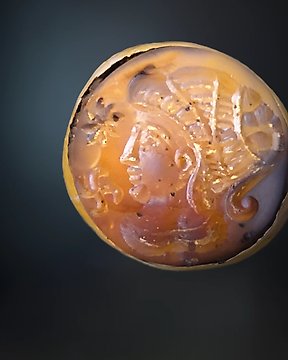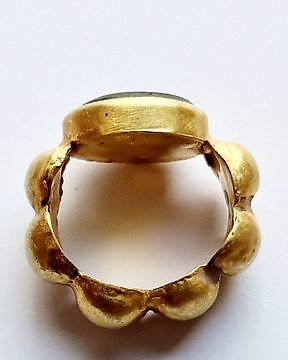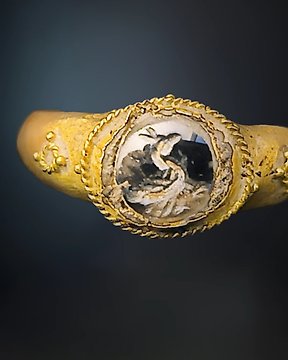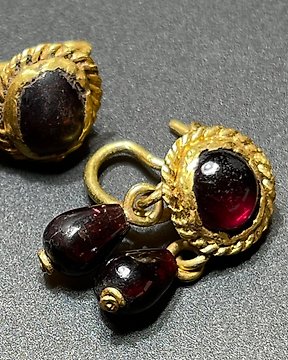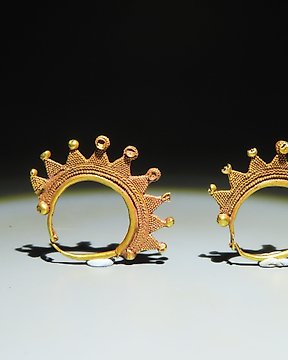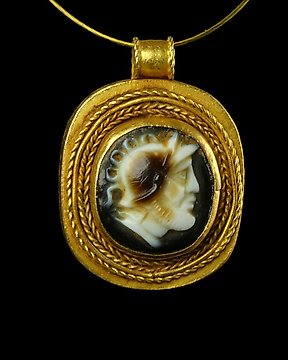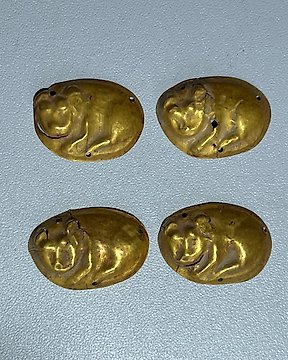Fast shipping perfect packaging the earring is gorgeous !! Everything perfect! Thank you very much
Übersetzung ansehenThank you for the nice feedback, enjoy your beautiful piece!
Catawiki nutzt immer die neuesten Technologien. Sie verwenden derzeit einen veralteten Browser. Aktualisieren Sie bitte Ihren Browser, damit Sie immer alle neuen Funktionen optimal nutzen können.
Über die folgenden Buttons können Sie Ihre Cookie-Einstellungen auswählen. Sie können Ihre bevorzugten Einstellungen ändern und Ihre Zustimmung jederzeit widerrufen. Eine detaillierte Beschreibung aller Arten von Cookies, die wir und unsere Partner verwenden, finden Sie in unserer Cookie-Erklärung.
Nr. 85654129





Collector's delight meets historical magnificence in this authentic Byzantine gold ring, dating from the 7th to 9th century CE. This exquisite piece embodies the Byzantine Empire's grandeur, revered for its luxury and aesthetic refinement. A harmonious blend of art and spirituality, Byzantine jewelry like this ring was not merely for adornment but also a display of wealth and piety.
CRAFTSMANSHIP THAT TRANSCENDS TIME
The ring's design, with its round band and intricate beadwork, is a testament to the skillful artisans of the time. The central ridge, flanked by ropework, culminates in a stunning blue sapphire cabochon secured by a funnel-shaped bezel and six projecting prongs. The sapphire, an emblem of celestial hope and faith, would have been highly prized, its deep blue hue symbolizing the heavens.
MATERIAL AND DESIGN: A SYMBOL OF DIVINITY
Crafted from 21 ct gold, the ring's material itself holds a narrative of ancient trade routes and exchanges. Gold, a sacred metal in Byzantine culture, was often sourced from diverse regions, including Nubia and Thrace. The sapphire's presence is equally significant; it would likely have been imported from the distant lands of Sri Lanka or the Indian subcontinent, illustrating the vast network of Byzantine trade.
PROVENANCE AND AUTHENTICITY
With a clear provenance tracing back to a private UK collection and connections to the esteemed R. A. collection, this ring's journey through time is well-documented. It has been vetted against the Art Loss Register, ensuring its legitimacy and adding an invaluable layer of trust for collectors. Its dimensions (D:18.75mm / US: 8 3/4 / UK: R) and weight (7g) speak to its substantial presence as a piece of historical jewelry.
COLLECTIBLE SIGNIFICANCE AND VALUE
For collectors, the ring is more than a precious object; it is a fragment of history. Jewelry from the first millennium CE is scarce, making this ring a rare find. The combination of its high-karat gold and sapphire, verified origin, and lack of modern trace elements ascertained through X-ray fluorescence analysis, marks it as a collectible of significant worth.
HISTORICAL AND CULTURAL IMPORTANCE
Byzantine society placed immense value on religious symbolism, and jewelry pieces like this ring were often used to convey the wearer's social status and devotion. The sapphire, associated with ecclesiastical dignity, would have been especially appropriate for high-ranking individuals in society, possibly clergy or nobility.
VISUAL ANALYSIS REPORT:
The sapphire cabochon set in this Byzantine gold ring is the centerpiece of its design, held in place by a distinctive funnel-shaped bezel, indicative of the era's regal aesthetic. The beadwork and ropework along the band highlight the meticulous detail valued by Byzantine jewelers. This ring, likely called a "seal ring," would have been used to signify status and possibly to stamp wax on documents, reflecting its owner's high rank and taste. Its preservation and style are rare, making it a coveted item for collectors seeking a tangible connection to the Byzantine Empire's sophistication.
XRF ANALYSIS REPORT:
The X-ray fluorescence (XRF) analysis of this Byzantine gold ring confirms its composition as 21 ct gold, indicating a purity that aligns with the opulent standards of the era. The absence of modern trace elements suggests the ring's authenticity, enhancing its value. The presence of a high-quality blue sapphire, set within a classic Byzantine bezel, completes this piece's luxurious profile. This combination of gold and gemstone is not only emblematic of the period's craftsmanship but also its rarity in contemporary collections.
PROVENANCE:
Acquired from the esteemed Apollo Galleries in London, UK. Accompanied with Certificate of Authenticity.
Collector's delight meets historical magnificence in this authentic Byzantine gold ring, dating from the 7th to 9th century CE. This exquisite piece embodies the Byzantine Empire's grandeur, revered for its luxury and aesthetic refinement. A harmonious blend of art and spirituality, Byzantine jewelry like this ring was not merely for adornment but also a display of wealth and piety.
CRAFTSMANSHIP THAT TRANSCENDS TIME
The ring's design, with its round band and intricate beadwork, is a testament to the skillful artisans of the time. The central ridge, flanked by ropework, culminates in a stunning blue sapphire cabochon secured by a funnel-shaped bezel and six projecting prongs. The sapphire, an emblem of celestial hope and faith, would have been highly prized, its deep blue hue symbolizing the heavens.
MATERIAL AND DESIGN: A SYMBOL OF DIVINITY
Crafted from 21 ct gold, the ring's material itself holds a narrative of ancient trade routes and exchanges. Gold, a sacred metal in Byzantine culture, was often sourced from diverse regions, including Nubia and Thrace. The sapphire's presence is equally significant; it would likely have been imported from the distant lands of Sri Lanka or the Indian subcontinent, illustrating the vast network of Byzantine trade.
PROVENANCE AND AUTHENTICITY
With a clear provenance tracing back to a private UK collection and connections to the esteemed R. A. collection, this ring's journey through time is well-documented. It has been vetted against the Art Loss Register, ensuring its legitimacy and adding an invaluable layer of trust for collectors. Its dimensions (D:18.75mm / US: 8 3/4 / UK: R) and weight (7g) speak to its substantial presence as a piece of historical jewelry.
COLLECTIBLE SIGNIFICANCE AND VALUE
For collectors, the ring is more than a precious object; it is a fragment of history. Jewelry from the first millennium CE is scarce, making this ring a rare find. The combination of its high-karat gold and sapphire, verified origin, and lack of modern trace elements ascertained through X-ray fluorescence analysis, marks it as a collectible of significant worth.
HISTORICAL AND CULTURAL IMPORTANCE
Byzantine society placed immense value on religious symbolism, and jewelry pieces like this ring were often used to convey the wearer's social status and devotion. The sapphire, associated with ecclesiastical dignity, would have been especially appropriate for high-ranking individuals in society, possibly clergy or nobility.
VISUAL ANALYSIS REPORT:
The sapphire cabochon set in this Byzantine gold ring is the centerpiece of its design, held in place by a distinctive funnel-shaped bezel, indicative of the era's regal aesthetic. The beadwork and ropework along the band highlight the meticulous detail valued by Byzantine jewelers. This ring, likely called a "seal ring," would have been used to signify status and possibly to stamp wax on documents, reflecting its owner's high rank and taste. Its preservation and style are rare, making it a coveted item for collectors seeking a tangible connection to the Byzantine Empire's sophistication.
XRF ANALYSIS REPORT:
The X-ray fluorescence (XRF) analysis of this Byzantine gold ring confirms its composition as 21 ct gold, indicating a purity that aligns with the opulent standards of the era. The absence of modern trace elements suggests the ring's authenticity, enhancing its value. The presence of a high-quality blue sapphire, set within a classic Byzantine bezel, completes this piece's luxurious profile. This combination of gold and gemstone is not only emblematic of the period's craftsmanship but also its rarity in contemporary collections.
PROVENANCE:
Acquired from the esteemed Apollo Galleries in London, UK. Accompanied with Certificate of Authenticity.
Fast shipping perfect packaging the earring is gorgeous !! Everything perfect! Thank you very much
Übersetzung ansehenThank you for the nice feedback, enjoy your beautiful piece!
Zeer zorgvuldig verzonden in mooie ringendoosjes. Dank!
Übersetzung ansehenGraag gedaan en veel plezier met deze prachtige ringen!
ottimo servizio arrivato tutto perfetto
Übersetzung ansehengrazie per la reazione positiva!
Très bel objet. Bien emballé et rapidement livré. Accompagné des documents nécessaires (coa, invoice). Je suis très satisfait et recommande ce vendeur.
Übersetzung ansehenThank you for the positive reply and enjoy this great addition to your collection!
Very Nice . Fast shipping. Thank you.
Übersetzung ansehenYou're welcome and thank you for selecting this fine piece to be part of your collection!
Das ist eine unglaubliche Objekt Ich danke Ihnen vielmals für Verkauf Alles sehr gut gegangen Danke
Übersetzung ansehenVielen Dank für Ihren Kauf und wir wünschen Ihnen viel Glück mit dieser feinen Ergänzung zu Ihrer Sammlung!
Fast shipping perfect packaging the earring is gorgeous !! Everything perfect! Thank you very much
Übersetzung ansehenThank you for the nice feedback, enjoy your beautiful piece!
Der Verkäufer garantiert und kann belegen, dass das Objekt legal erworben wurde. Der Verkäufer wurde von Catawiki darüber informiert, dass er die Unterlagen, die gemäß den Gesetzen und Vorschriften seines Landes erforderlich sind, zur Verfügung stellen muss. Der Verkäufer garantiert, dass er berechtigt ist, das Objekt zu verkaufen/auszuführen. Der Verkäufer wird dem Käufer alle Informationen, die zur Provenienz des Objekts vorliegen, zur Verfügung stellen. Der Verkäufer versichert, dass alle erforderlichen Genehmigungen eingeholt wurden/werden. Der Verkäufer wird den Käufer unverzüglich über etwaige Verzögerungen bei der Einholung dieser Genehmigungen informieren.
Der Verkäufer garantiert und kann belegen, dass das Objekt legal erworben wurde. Der Verkäufer wurde von Catawiki darüber informiert, dass er die Unterlagen, die gemäß den Gesetzen und Vorschriften seines Landes erforderlich sind, zur Verfügung stellen muss. Der Verkäufer garantiert, dass er berechtigt ist, das Objekt zu verkaufen/auszuführen. Der Verkäufer wird dem Käufer alle Informationen, die zur Provenienz des Objekts vorliegen, zur Verfügung stellen. Der Verkäufer versichert, dass alle erforderlichen Genehmigungen eingeholt wurden/werden. Der Verkäufer wird den Käufer unverzüglich über etwaige Verzögerungen bei der Einholung dieser Genehmigungen informieren.
